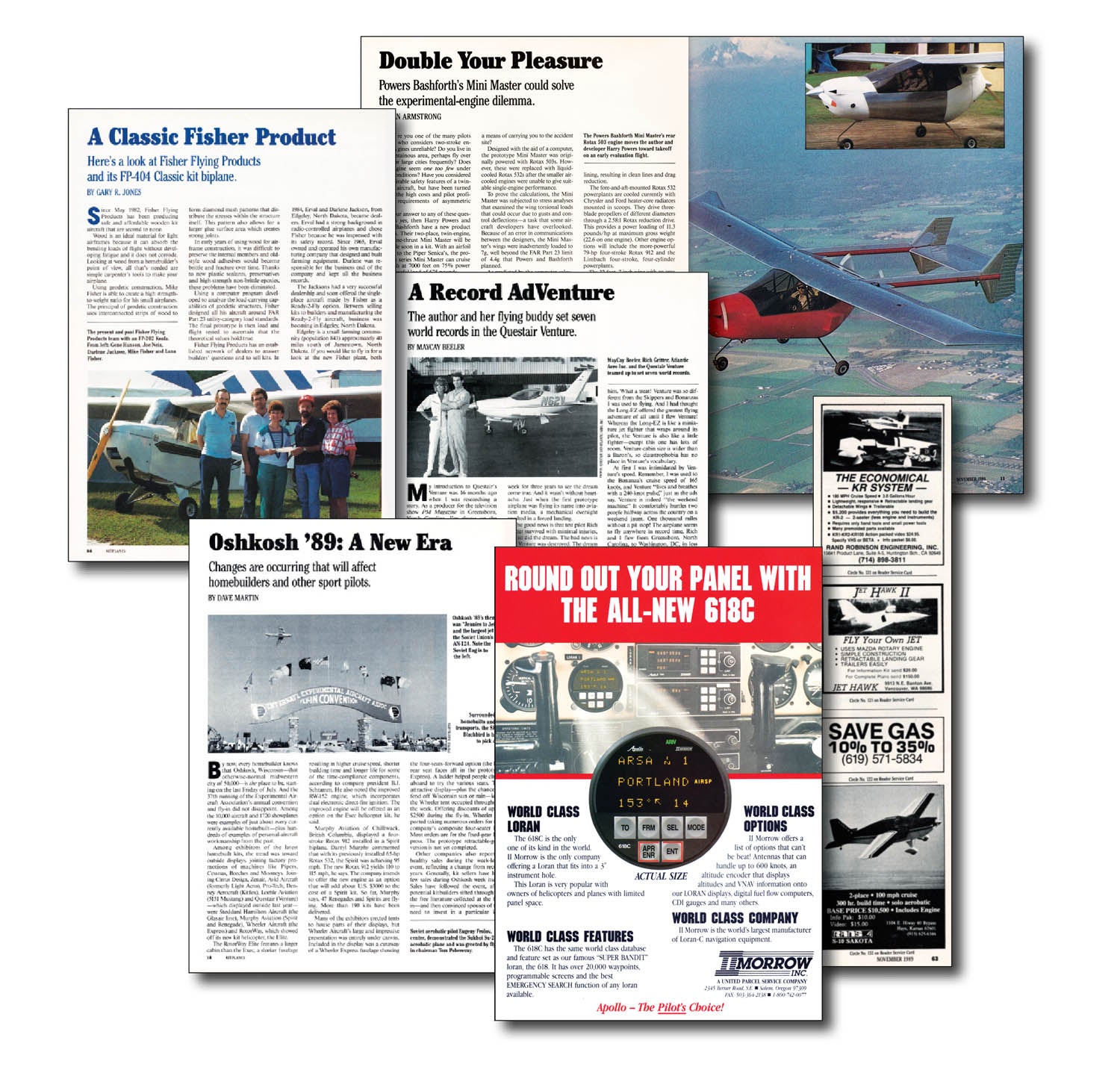 The airplane on our November 1989 cover was not some kind of Cessna 336 that got left in the dryer too long. Indeed, it was the Mini Master, a design intended to “solve the experimental-engine dilemma.” Author Ken Armstrong’s report noted that the Mini Master, with an airfoil similar to a Piper Seneca’s, could cruise at 115 mph and had a useful load of 675 pounds. “Designed with the aid of a computer,” the story noted, “the prototype Mini Master was originally powered with Rotax 503s. However, these were replaced with liquid-cooled Rotax 532s after the smaller air-cooled engines were unable to give suitable single-engine performance.” Armstrong noted a “cruise” speed of 96 mph with both Rotaxes running 6000 rpm. With the front engine shut down, the airplane could manage a 400-fpm climb. With the rear shut down, it was 300 fpm. This performance actually mirrors the Cessna Skymaster, which climbs a bit better on the rear engine.
The airplane on our November 1989 cover was not some kind of Cessna 336 that got left in the dryer too long. Indeed, it was the Mini Master, a design intended to “solve the experimental-engine dilemma.” Author Ken Armstrong’s report noted that the Mini Master, with an airfoil similar to a Piper Seneca’s, could cruise at 115 mph and had a useful load of 675 pounds. “Designed with the aid of a computer,” the story noted, “the prototype Mini Master was originally powered with Rotax 503s. However, these were replaced with liquid-cooled Rotax 532s after the smaller air-cooled engines were unable to give suitable single-engine performance.” Armstrong noted a “cruise” speed of 96 mph with both Rotaxes running 6000 rpm. With the front engine shut down, the airplane could manage a 400-fpm climb. With the rear shut down, it was 300 fpm. This performance actually mirrors the Cessna Skymaster, which climbs a bit better on the rear engine.
Inside the issue, we covered the 1989 edition of Oshkosh—not yet dubbed AirVenture—and noted the reshuffling of the displays for homebuilts, which were gradually moving from indoor booths to full outdoor exhibits. In addition, then-editor Dave Martin noted that the ultralight and rotorcraft areas, which had moved away from show center, had found new life and the demo pilots there appreciated being able to fly off the grass. In case you were wondering, that year’s Grand Champion homebuilt was Ralph Lauritsen’s RV-4. The other winners included another RV-4, a Velocity, a Q-200 and four Glasairs.

Rich Gritter and MayCay Beeler separately documented their record attempts in the Questair Venture homebuilt. The egg-shaped, all-metal airplane set out, with the crew of two, to break seven NAA records, five for speed and two for climb performance. They beat all seven existing records with these finishes: 3 minutes, 43 seconds to climb from sea level to 3000 meters (9842 feet); 8 minutes, 18 seconds to 6000 meters (19,686 feet); 331.75 mph on the 3-km open course; 302.67 mph on the 15/25-km open course; 305.13 mph on the 100-km closed course; 284.76 mph for the 500-km closed course; and 283.88 mph for the 1000-km closed course.
Gary Jones flew the Fisher FP-404 biplane. “Looking at the Fisher product line reminds me of going to a nice restaurant with so many entrees on the menu that it is hard to make a choice,” Jones said. Fisher’s Gene Hanson explained that many of the Fisher products shared parts, so that manufacturing wasn’t as complicated as the number of models would suggest. “The Classic is as easy to fly as it is fun. I would recommend that a pilot get checked out in a taildragger before flying his handiwork, but as taildraggers go, the Classic is very forgiving.”
Our Completions section included a Fisher FP-404 EXP, a Poliwagon and a Goldwing. Ads in this issue included small inserts for the Rand Robinson KR, the Jet Hawk II “fly your own jet” and the mid-wing RANS S-10 Sakota. Inside the front cover was a full-page ad for II Morrow’s round-format 618C loran navigator that included a 20,000-waypoint database. Hot stuff.














It’s interesting, to me at least, that you show that particular cover. That airplane was on the ramp at Arlington (KAWO) when I first go there. In fact, where it was parked is not far from where my current hangar is. I thought it was an interesting idea. My Dad was so enthused about we tried to track down the owner to make an offer to buy it, but we had no luck.
I think it would have been fun to rebuild it and put some newer engines in it.